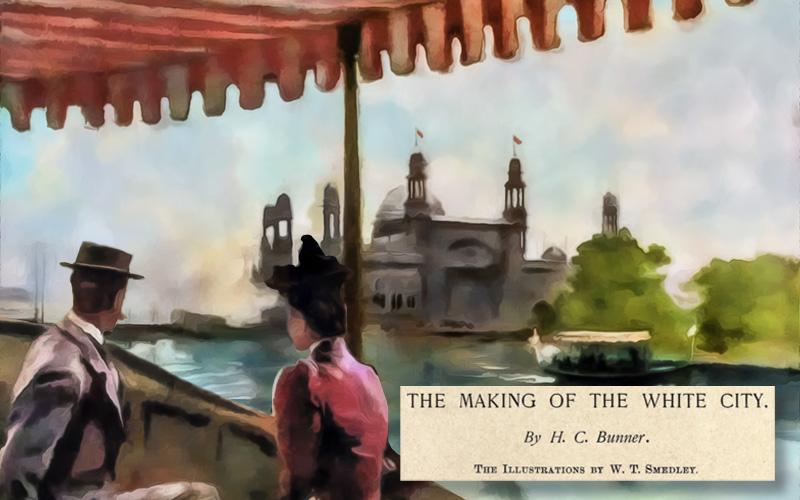
Few essays about the fairgrounds for the 1893 World’s Columbian Exposition better capture the creative energy of its construction than H. C. Bunner’s “The Making of the White City.” The American novelist, journalist, and poet Henry Cuyler Bunner (1855–1896) visited Jackson Park in Chicago during the summer of 1892. There he witnessed laborers assembling the great exhibit halls, hundreds of smaller structures, and magnificent landscaping in advance of the October 1892 Dedication Day ceremony.
While Bunner employs an ornate and poetic writing style, evoking Coleridge’s “Kubla Khan” several times, his essay also provides important technical details of how the White City was constructed. “The whole thing is a sketch,” he reveals to readers. The fairgrounds served as “positively theatrical” stage set of fantastic proportions. He ends the piece with a critique, “more earnestness than art,” of most of the principal exhibit halls, including a pointed rebuke of Louis Sullivan’s polychromatic Transportation Building.
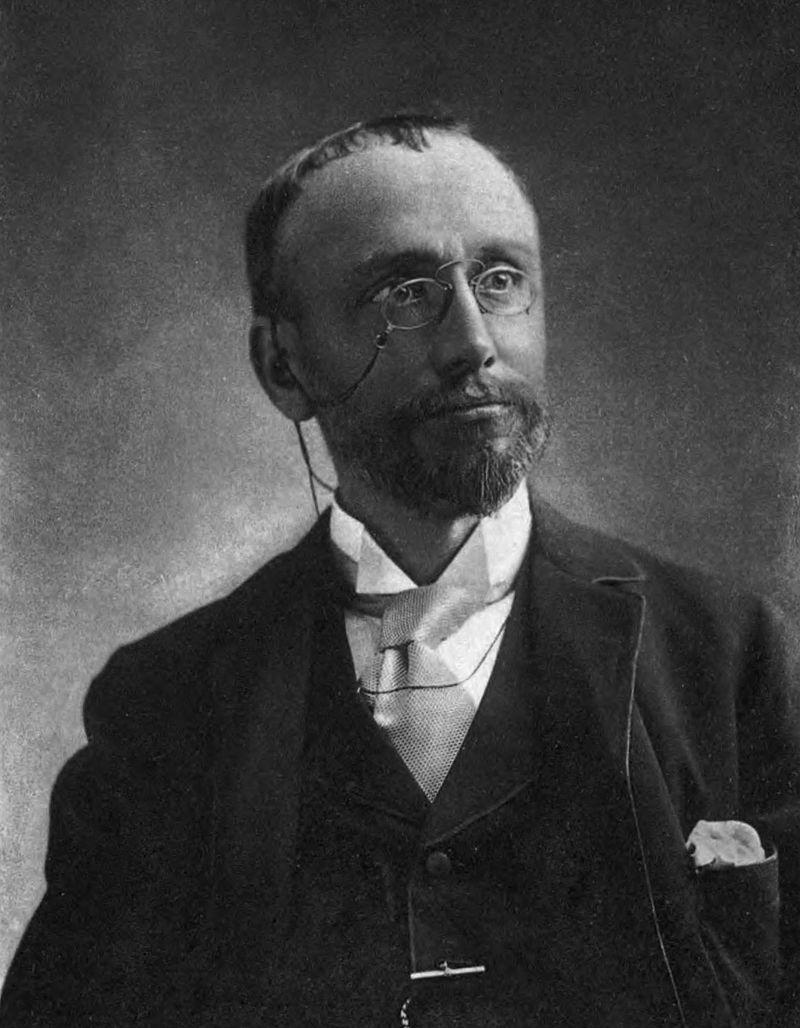
Henry Cuyler Bunner [Image from The Poems of H. C. Bunner (Charles Scribner’s sons, 1896)]
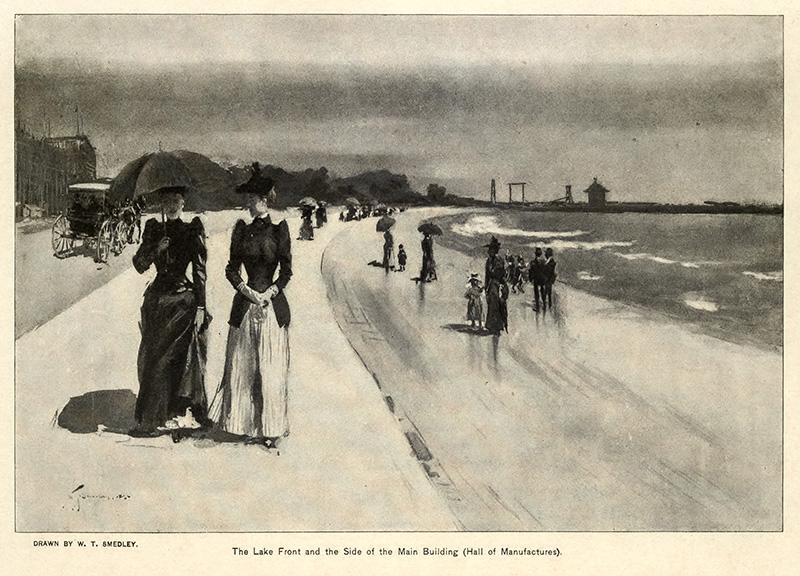
“The Lake Front and the Side of the Main Building (Hall of Manufactures)” by W. T. Smedley [Image from Scribner’s Magazine October, 1892 (Vol. 12, No. 4), pp. 399–418.]
THE MAKING OF THE WHITE CITY.
By H. C. Bunner.
On the shore of a wide, blue-gray lake, under a northern sky, veiled over half its horizon with a dim, smoky mist, there spread, two years ago, a waste and desolate sand plain with a streak of marshy pools in the heart of it. Here and there were trunks of scrubby trees and patches of starveling underbrush; but it had none of the pleasant loneliness of the countryside: the bleak desolation of a great city’s waste outskirts brooded over the whole tract. On the west the space was bounded by the flat broad roadbed of a suburban railroad; eastward a strong wall of ponderous masonry stood between it and the sullen swash of the inland sea. To the south it went out of sight in loneliness; on the north it narrowed to a point where a great town had begun a fight with nature for a few acres of pleasure-ground, stubbornly pushing a green covering of young trees and grass across the unwilling sand. Beyond this patch of verdure trailed out the city’s myriad streets, sparsely settled here, for the town proper lay eight miles away in the heart of the smoky haze that floated along the skyline.
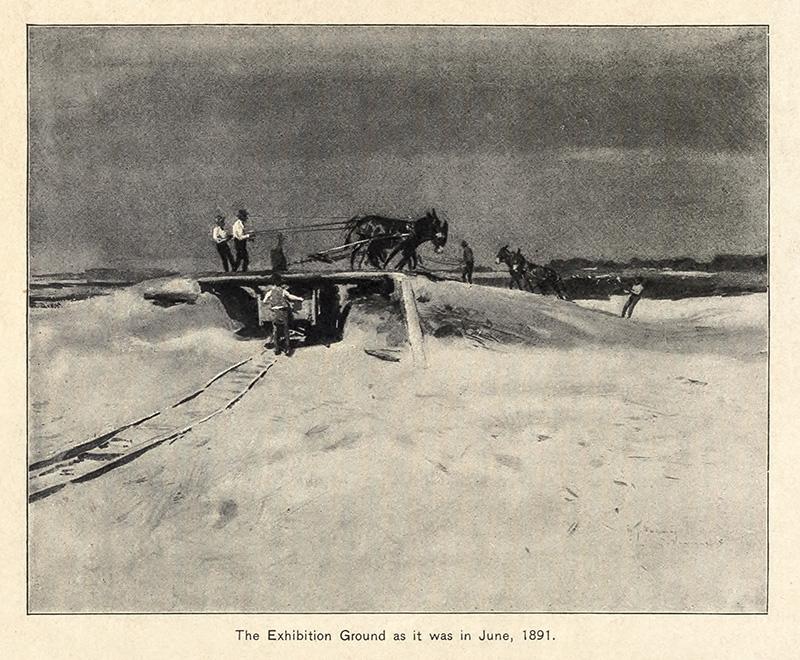
“The Exhibition Ground as it was in June, 1891” by W. T. Smedley [Image from Scribner’s Magazine October, 1892 (Vol. 12, No. 4), pp. 399–418.]
A gracious and well-ordered garden, a white city of glass and iron
In the month of June, 1891, a man stuck the nose of a plough into the sand of this plain, by way of beginning an undertaking which lay before him, and before some scores of thousands of working men all over the country—day-laborers, like himself; iron-forgers, architects, truckmen, carpenters, painters, surveyors, glaziers, designers, moulders, joiners, masons, gardeners—men of every trade and art and handicraft, of every nationality, of every class and kind of humanity, working together in widely separate places for the accomplishment of one common purpose. Today, in the prosecution of this undertaking, the surface of that waste plain has become the scene of one of the most marvellous manifestations of mechanical achievement which the world has to offer; it is the site of such a group of buildings as has never before been assembled for such a purpose, on such a scale, within such a time, and in such conditions. It sounds like an extravagance to say that within this space of half a thousand acres is concentrated the energy, the skill, the intelligence, the activity, equipped with every material requisite, that would suffice to build up a large city in the space of three years; but to this plain statement of fact must be added this other: that the city is built. He who goes to that lake-side desert a year from now will see, rising from a gracious and well-ordered garden, a white city of glass and iron, a system of structures gigantic in plan and scope beyond anything that science has hitherto held feasible or desirable for the sheltering of a multitude of pleasure-seekers.
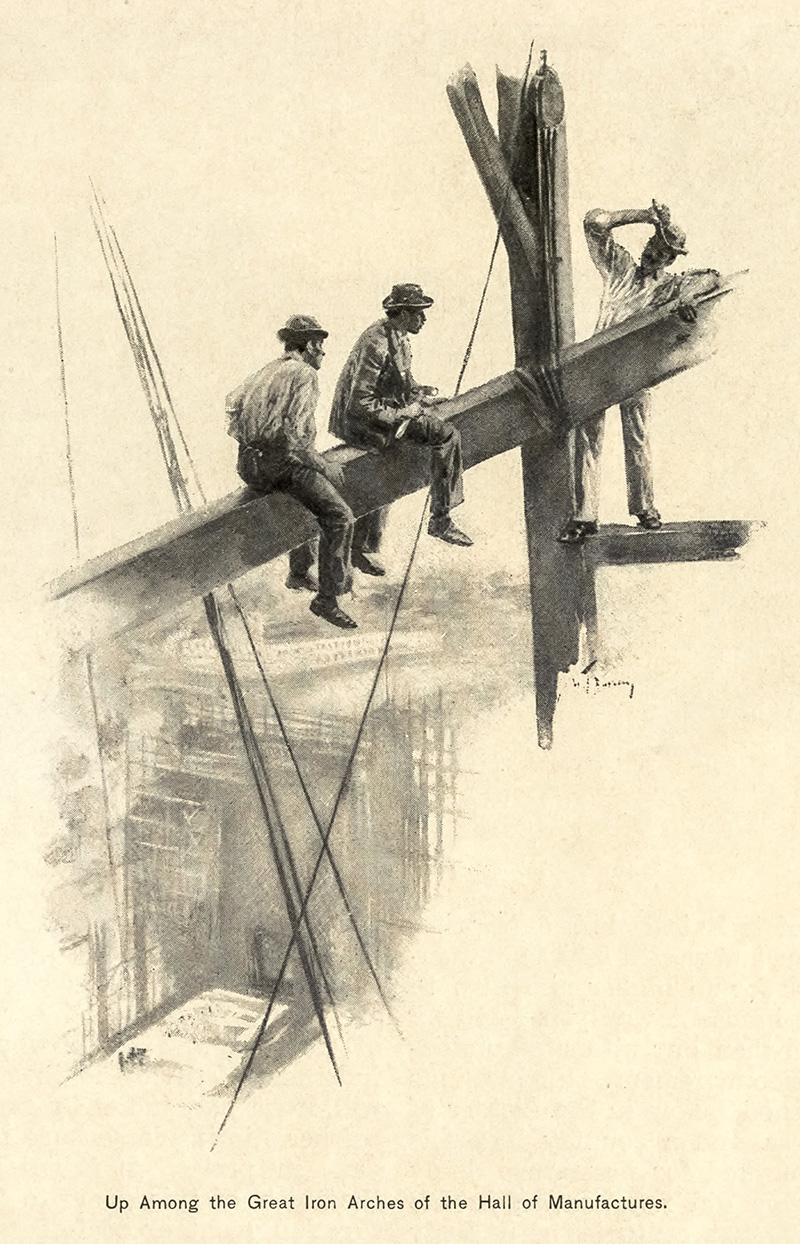
“Up Among the Great Iron Arches of the Hall of Manufactures” by W. T. Smedley [Image from Scribner’s Magazine October, 1892 (Vol. 12, No. 4), pp. 399–418.]
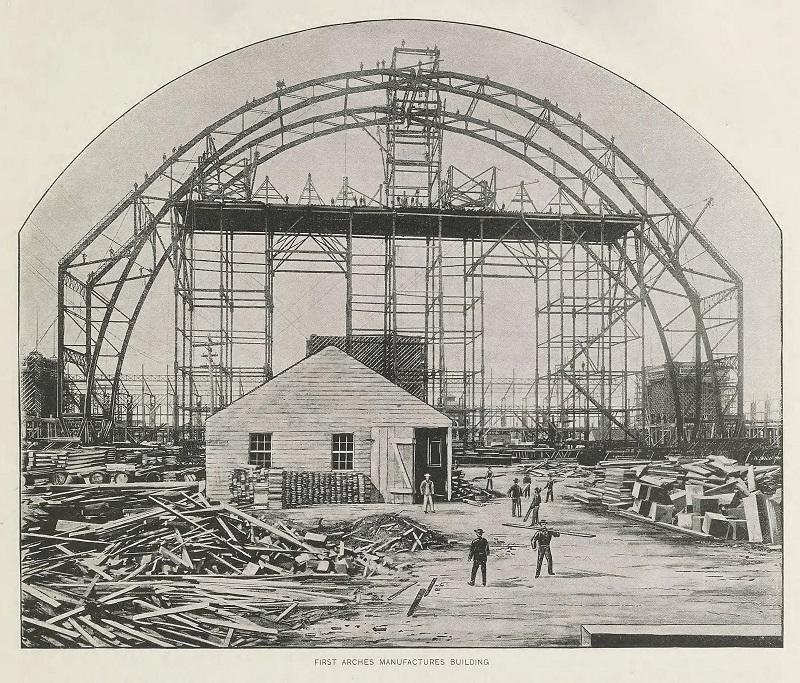
Among the giants of the White City stood the Manufactures and Liberal Arts Building, then the largest building ever constructed. The sheer magnitude of this building presented to visitors “a scale so unusual that the physical eye is tricked” This photograph shows the first arches of the eventual structure. [Image from Bancroft, Hubert Howe The Book of the Fair. The Bancroft Company, 1893.]
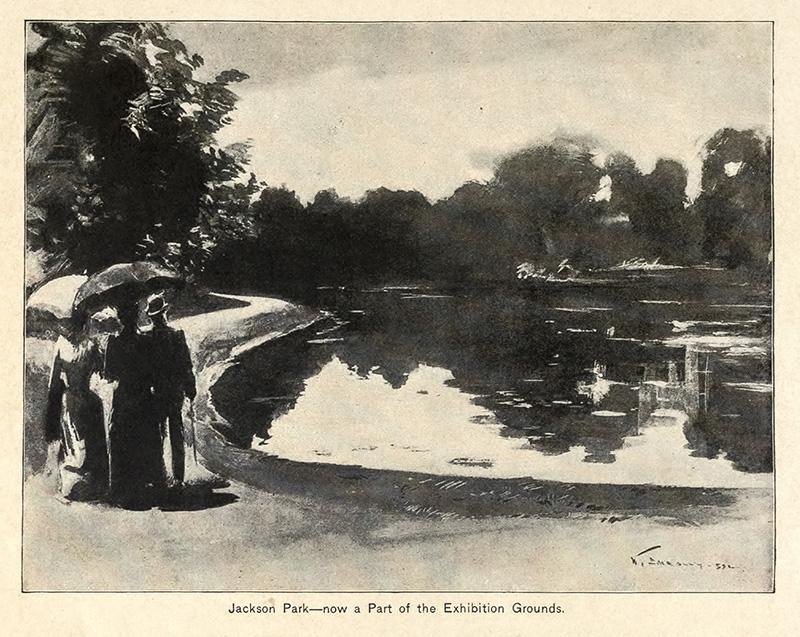
“Jackson Park—now a Part of the Exhibition Grounds” by W. T. Smedley [Image from Scribner’s Magazine October, 1892 (Vol. 12, No. 4), pp. 399–418.]
Turn a barren wilderness into a garden
When the conduct of the World’s Fair was allotted by Congress to the city of Chicago, it cannot be denied that there was a general fear, and that there was generally good ground for that fear, that Chicago’s conception of the housing of the World’s Fair might be more interesting for material breadth than for aesthetic height; and the fear has certainly not been lessened by the report of Chicago’s adoption of the Brobdingnagian scale.
Eighteen hundred and ninety-three and the opening of the World’s Fair will come soon enough to show us how well this country, represented by her second greatest city, has assumed the burden which the performance of such a task imposes upon her loyalty to art, her good taste and her catholicity of interest, and those who form the judgment of the world in such matters will, if we may judge by experience, be neither stinting in censure nor extravagant in praise. It is not in any way the object of this paper to forerun mature judgment or to forecast the value of the finished work. It aims simply to give some portrayal of a most interesting phase and of a great and singular activity, to sketch an imposing and bewildering work at its most significant stage, and to show the lines on which the men who have been chosen for the mighty task are endeavoring to carry out the behest of the state, and turn in less than forty months a barren wilderness into a garden of palaces—to let the work that is being done at Chicago speak for itself.
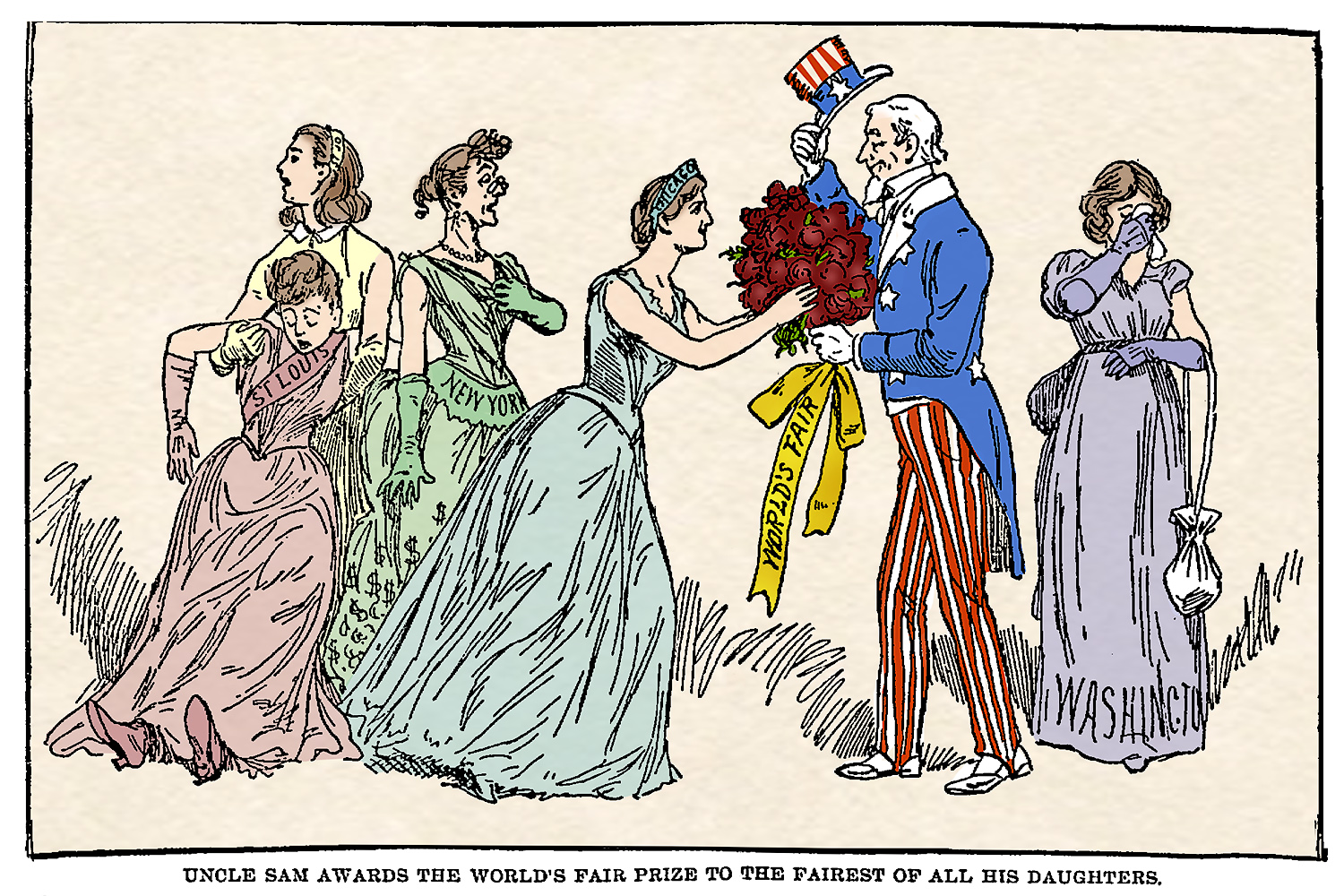
Bunner describes the often-bitter rivalry between New York (unnamed in his essay) and Chicago in 1889 and 1890 as they each vied to win congressional approval to host the Columbian Exposition. [Colorized image based on cartoon in the February 25, 1890, Chicago Daily Tribune.]
Sputtering hysteria
It is necessary to turn first to one page of the history of the Fair—not the page that tells of the extraordinary exhibition of indecorum made at one time by two great cities, each for itself, as well as in their relations with each other. No, the page we would turn to bears pleasanter reading. It tells of doing of the biggest and best thing that has yet been done in the whole business of the World’s Fair—of a bigger and better thing than the building of the biggest and best temple of pleasure that ever reared a white forehead against a smoky sky. It is something, too, that could only have been done in America.
The quarrel which resulted in the World’s Fair going to Chicago was a credit to neither of the two principal contestants. It reflected unpleasantly upon American civilization, in that it was carried on with the brutal acrimony of an English parliamentary campaign and the sputtering hysteria of an interpellation in the French Chamber of Deputies. On the one side was an old city—old as age goes in this new world—with every facility for handling such an affair, with experience in managing and providing for crowds, and for furnishing comfort and amusement, split into two furious factions of anxious citizens. Both factions wanted the privilege of having the Fair; what they disagreed about was the propriety of buying that privilege with the ruin of an irreplaceable and perhaps an incomparable park. On the other hand was Chicago—new, energetic, enthusiastic, untrammelled—with a unanimity of opinion among her citizens that evoked the praise and wonder of the world. Such unanimity deserved the prize, and won it.
But, face to face at last with the responsibility and the task, Chicago sat down to consider coldly some of the limitations of the usefulness of unanimity, and to discern, perhaps, a certain spiritual significance in the difference of opinion which had seemed almost incomprehensible when she saw it vexing the disunited Eastern mind. There is a unanimity that comes from the ordered training of many intellects to work for a single end. There is also the unanimity which hails the ascending rocket with the imitative hiss of admiration. The course of that unanimity during the further career of the rocket has often been noted.
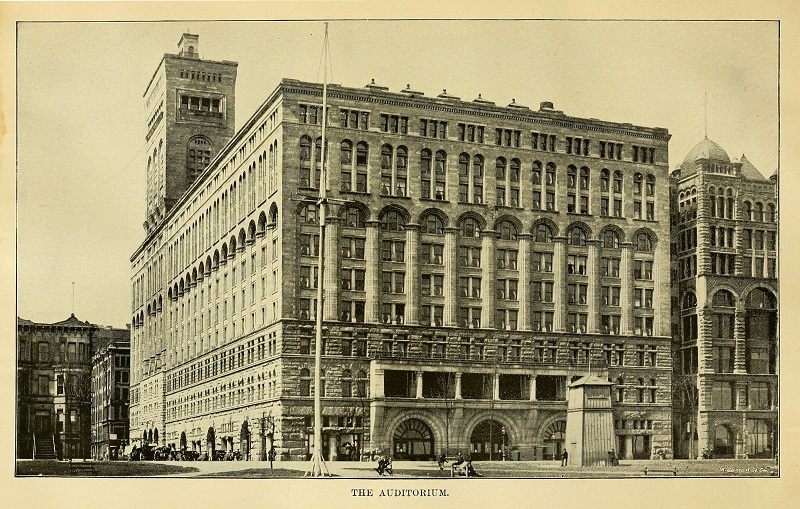
The Auditorium in downtown Chicago attracted national attention as “the tallest hotel in the world” and helped win the bod to host the 1893 World’s Fair. [Image from Artistic Guide to Chicago and the World’s Columbian Exposition. R.S. Peale, 1891.]
Coaxing of a smile upon the dull face of nature
The undertaking she had in hand necessarily brought with it the necessity of considering certain problems that could not but be new to a new civilization. Perhaps, more than any other town, Chicago has made it her boast that her equipment of energy, material, and resource was always kept equal to her demand upon it. Other cities might have to wait for men, time, or money to bring about a realization of their dreams; Chicago kept her force of realizers always on duty and ready for every emergency. Whatever she wanted she had, and as soon as she made up her mind that she wanted it whether it was the tallest hotel in the world or the system of express passenger elevators needed to make fourteenth story offices as accessible as those on the third floor.
No doubt she made good her boast. But her new obligation introduced her to several wants which she had never before had to consider, and which she was wholly unprepared to meet. The satisfaction of utilitarian requirements, with a reasonable desire to give beauty a fair show at the same time, had hitherto been the formula of Chicago’s artistic growth. Even in the laying out of her great parks she had attempted little more than the forcing of an existent flatness and monotony into a more agreeable diversity of form and feature, yet while this coaxing of a smile upon the dull face of nature must be admired as a clever performance under most trying conditions, it cannot be held more than a compromise with abstract beauty—a plucky attempt to wrest from an un willing soil the public playground’s natural birthright. The little artificial hills and dales of Lincoln Park were, however, Chicago’s boldest essay for the sake, primarily, of the aesthetic rather than the useful. That is to say, for the special work she bad taken upon herself she lacked not only the necessary special preparation, but the situation she faced was one unforeseen in her plan of life and alien to the essential idea of her self-education. Two courses lay open to her; to degrade the work to the level of her own aptitude at the moment, or to carry out her trust in the highest spirit of loyalty and faithfulness, at whatever cost to a local pride, that must have been most sensitive, exacting, and sanguine in the flush of recent victory. Chicago probably has not as yet realized the size of her achievement in adopting the latter alternative; it is not measurable in stone-perches, but it is the biggest thing in Chicago’s list all the same.
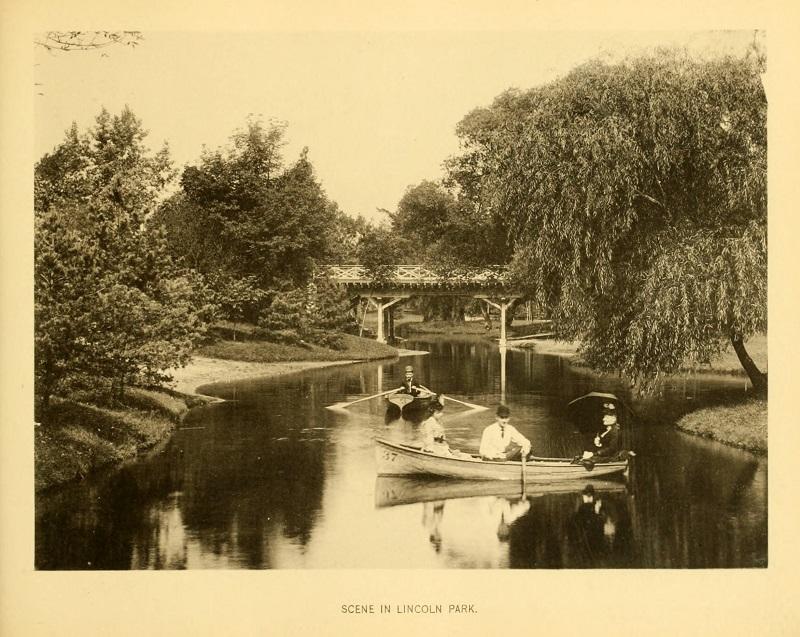
A scene in Lincoln Park, on Chicago’s North Side, in 1892. [Image from Wittemann, A. Views of Chicago. A. Wittemann, 1892.]
The heartiest encouragement and assistance
It must, however, be recorded with regret that the recognition of the necessity of outside help came as an afterthought; it was demonstrated, indeed, by injudicious and unsuccessful attempt. The valuable aid that was invoked came too late to deal with the scheme of construction as a complete, perfect, and independent whole. When Chicago called the best architects and landscape-gardeners to her aid they found that a part of the task before them was the coordination with their own plans of certain features not of their own origination. But it seems as if the very difficulty of doing this had added something to the enthusiasm and determination with which they undertook the work. Let us add that it was the only important drawback they had to encounter. The work that was handed over was handed over without reservation or restriction, and with their authority they received the fullest possible means of accomplishment and the heartiest encouragement and assistance.
[Continued in Part 2]
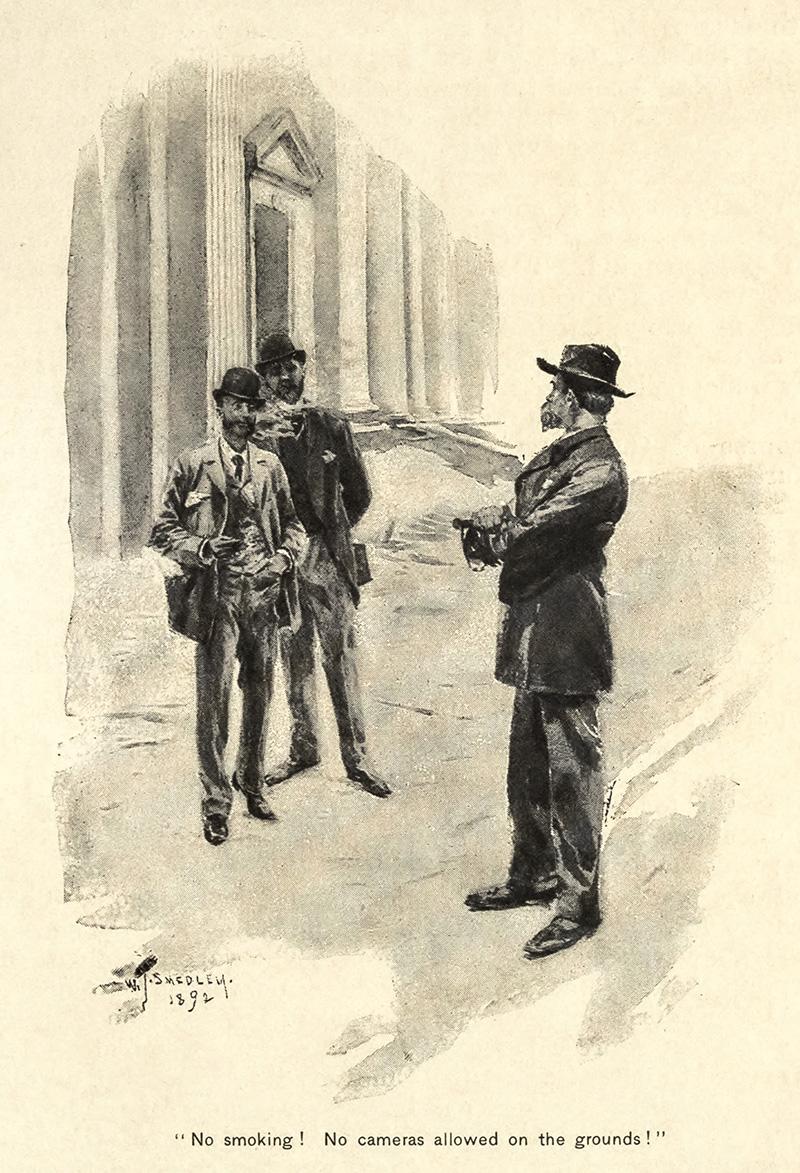
“No smoking! No cameras allowed on the grounds” by W. T. Smedley highlights two battled waged by the Exposition: preventing fire in a city build of wood and plaster and strictly controlling the images of the Exposition seen by the public. [Image from Scribner’s Magazine October, 1892 (Vol. 12, No. 4), pp. 399–418.]

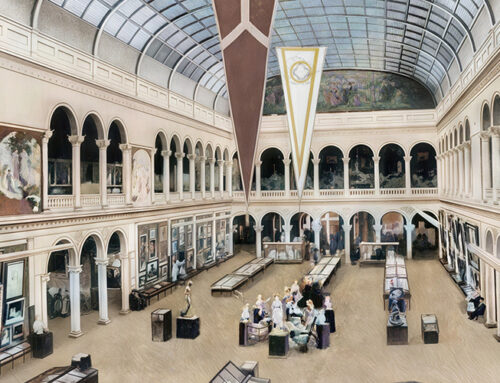
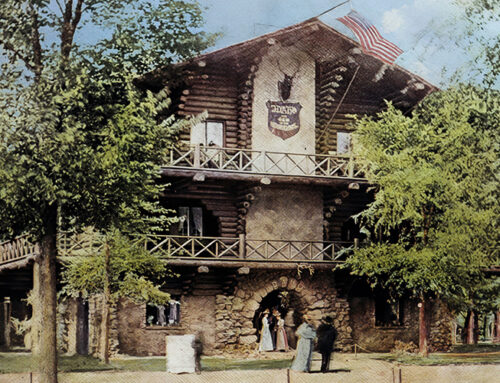
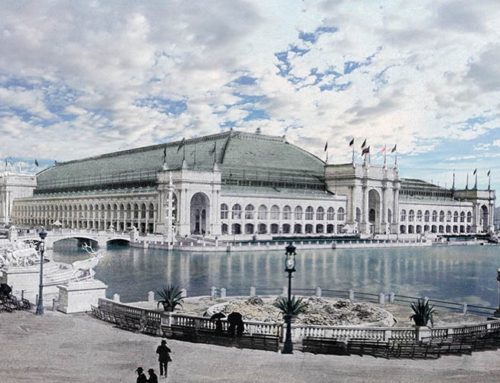
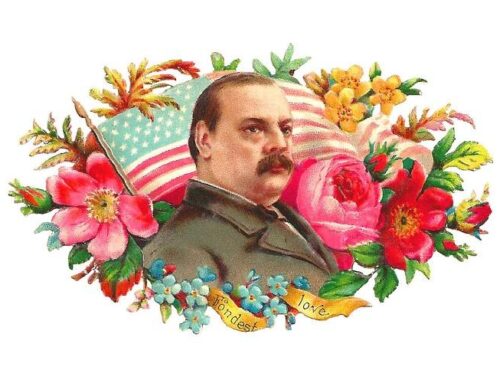
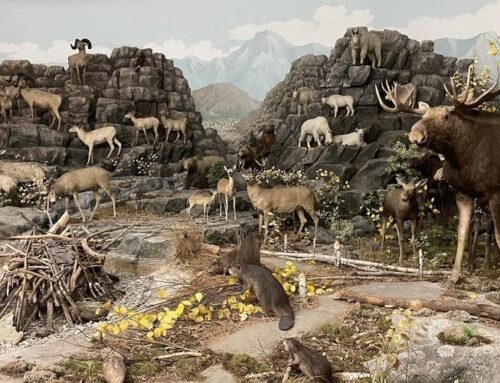
Leave A Comment